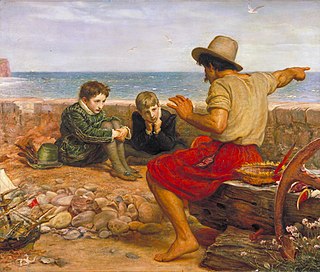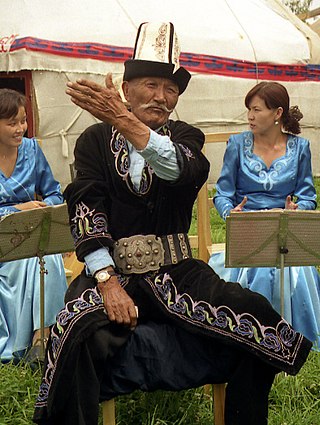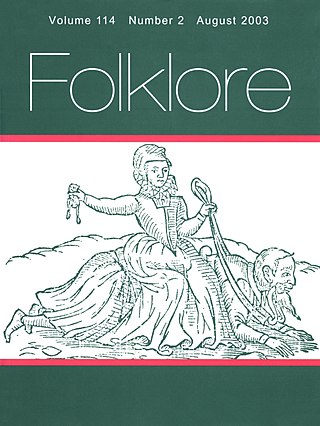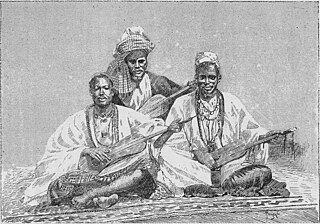Related Research Articles

Folklore is the body of expressive culture shared by a particular group of people, culture or subculture. This includes oral traditions such as tales, myths, legends, proverbs, poems, jokes, and other oral traditions. This also includes material culture, such as traditional building styles common to the group. Folklore also encompasses customary lore, taking actions for folk beliefs, and the forms and rituals of celebrations such as Christmas, weddings, folk dances, and initiation rites.

A tradition is a system of beliefs or behaviors passed down within a group of people or society with symbolic meaning or special significance with origins in the past. A component of cultural expressions and folklore, common examples include holidays or impractical but socially meaningful clothes, but the idea has also been applied to social norms and behaviors such as greetings etc. Traditions can persist and evolve for thousands of years— the word tradition itself derives from the Latin word tradere literally meaning to transmit, to hand over, to give for safekeeping. While it is reportedly assumed that traditions have an ancient history, many traditions have been invented on purpose, whether it be political or cultural, over short periods of time. Various academic disciplines also use the word in a variety of ways.
An oral law is a code of conduct in use in a given culture, religion or community application, by which a body of rules of human behaviour is transmitted by oral tradition and effectively respected, or the single rule that is orally transmitted.

Storytelling is the social and cultural activity of sharing stories, sometimes with improvisation, theatrics or embellishment. Every culture has its own stories or narratives, which are shared as a means of entertainment, education, cultural preservation or instilling moral values. Crucial elements of stories and storytelling include plot, characters and narrative point of view. The term "storytelling" can refer specifically to oral storytelling but also broadly to techniques used in other media to unfold or disclose the narrative of a story.

Oral tradition, or oral lore, is a form of human communication wherein knowledge, art, ideas and cultural material is received, preserved, and transmitted orally from one generation to another. The transmission is through speech or song and may include folktales, ballads, chants, prose or poetry. In this way, it is possible for a society to transmit oral history, oral literature, oral law and other knowledge across generations without a writing system, or in parallel to a writing system. Religions such as Buddhism, Hinduism, Catholicism, and Jainism, for example, have used an oral tradition, in parallel to a writing system, to transmit their canonical scriptures, rituals, hymns and mythologies from one generation to the next. Sub-Saharan African societies have broadly been labelled as "oral civilisations", contrasted with "literate civilisations", due to the emphasis placed on oral tradition and the important place it has in their cultures.

A narrative, story, or tale is any account of a series of related events or experiences, whether nonfictional or fictional. Narratives can be presented through a sequence of written or spoken words, through still or moving images, or through any combination of these. The word derives from the Latin verb narrare, which is derived from the adjective gnarus. The formal and literary process of constructing a narrative—narration—is one of the four traditional rhetorical modes of discourse, along with argumentation, description, and exposition. This is a somewhat distinct usage from narration in the narrower sense of a commentary used to convey a story. Many additional narrative techniques, particularly literary ones, are used to build and enhance any given story.
Media ecology theory is the study of media, technology, and communication and how they affect human environments. The theoretical concepts were proposed by Marshall McLuhan in 1964, while the term media ecology was first formally introduced by Neil Postman in 1968.
Communications management is the systematic planning, implementing, monitoring, and revision of all the channels of communication within an organization and between organizations. It also includes the organization and dissemination of new communication directives connected with an organization, network, or communications technology. Aspects of communications management include developing corporate communication strategies, designing internal and external communications directives, and managing the flow of information, including online communication. It is a process that helps an organization to be systematic as one within the bounds of communication.

Folklore studies is the branch of anthropology devoted to the study of folklore. This term, along with its synonyms, gained currency in the 1950s to distinguish the academic study of traditional culture from the folklore artifacts themselves. It became established as a field across both Europe and North America, coordinating with Volkskunde (German), folkeminner (Norwegian), and folkminnen (Swedish), among others.
The word oral may refer to:

Oral literature, orature, or folk literature is a genre of literature that is spoken or sung as opposed to that which is written, though much oral literature has been transcribed. There is no standard definition, as anthropologists have used varying descriptions for oral literature or folk literature. A broad conceptualization refers to it as literature characterized by oral transmission and the absence of any fixed form. It includes the stories, legends, and history passed through generations in a spoken form.
The history of communication technologies have evolved in tandem with shifts in political and economic systems, and by extension, systems of power. Communication can range from very subtle processes of exchange to full conversations and mass communication. The history of communication itself can be traced back since the origin of speech circa 100,000 BCE. The use of technology in communication may be considered since the first use of symbols about 30,000 years BCE. Among the symbols used, there are cave paintings, petroglyphs, pictograms and ideograms. Writing was a major innovation, as well as printing technology and, more recently, telecommunications and the Internet.

A Punjabi Qissa is a tradition of Punjabi language oral story-telling that emerged in Punjab region of eastern Pakistan and northwestern India, with the fusion of local Punjabi people and migrants from the Arabian peninsula and contemporary Iran.
Traditional stories, or stories about traditions, differ from both fiction and nonfiction in that the importance of transmitting the story's worldview is generally understood to transcend an immediate need to establish its categorization as imaginary or factual. In the academic circles of literature, religion, history, and anthropology, categories of traditional story are important terminology to identify and interpret stories more precisely. Some stories belong in multiple categories and some stories do not fit into any category.
Oral history preservation is the field that deals with the care and upkeep of oral history materials, whatever format they may be in. Oral history is a method of historical documentation, using interviews with living survivors of the time being investigated. Oral history often touches on topics scarcely touched on by written documents, and by doing so, fills in the gaps of records that make up early historical documents.
Yuri Rozhdestvensky - Russian rhetorician, educator, linguist and philosopher. Rozhdestvensky started his scholarly career from writing on Chinese grammar; his second Ph.D. involved the study and comparison of 2,000 grammars and established several language universals; he then moved on to comparative study of Chinese, Indian, Arabic and European rhetorical traditions, and then to the study of general laws of culture. Rozhdestvensky's influence continues to be powerful. In his lifetime, he directed 112 dissertations. His students now teach culture, media ecology, linguistics and communication theory courses in leading colleges in Russia.

Circa 1230s-1600s, the MaliEmpire was created in Western Africa along the Niger River. Often associated with being founded by Sunjata Keita, the history of Mali is extremely based on oral history. The story of the founder of Mali, Sunjata Keita, is largely based on oral history. Oral history may be defined as the preservation and interpretation of historical, cultural or personal experiences by way of a speaker. In Mali, such a speaker can be described as a poet, a storyteller, a praise singer or a musician. A large amount of Mali's history is transferred via oral historians. Such oral historians in Mali are known as griots, Jalis, and Jelis. The origins of oral history in Mali may be traced back to the story of Sunjata Keita. Modern-day oral history in Mali has transformed from the history based griots to a more contemporary musical and negotiator based griots. The current state of oral history in Mali has travelled to other realms like popular culture and politics.
Personal narrative (PN) is a prose narrative relating personal experience usually told in first person; its content is nontraditional. "Personal" refers to a story from one's life or experiences. "Nontraditional" refers to literature that does not fit the typical criteria of a narrative.
Family folklore is the branch of folkloristics concerned with the study and use of folklore and traditional culture transmitted within an individual family group. This includes craft goods produced by family members or memorabilia that have been saved as reminders of family events. It includes family photos, photo albums, along with bundles of other pages held for posterity such as certificates, letters, journals, notes, and shopping lists. Family sayings and stories which recount true events are retold as a means of maintaining a common family identity. Family customs are performed, modified, sometimes forgotten, created or resurrected with great frequency. Each time the result is to define and solidify the perception of the family as unique.
Indigenous cultures in North America engage in storytelling about morality, origin, and education as a form of cultural maintenance, expression, and activism. Falling under the banner of oral tradition, it can take many different forms that serve to teach, remember, and engage Indigenous history and culture. Since the dawn of human history, oral stories have been used to understand the reasons behind human existence. Today, Indigenous storytelling is part of the broader indigenous process of building and transmitting indigenous knowledge.
References
- ↑ "by word of mouth". thefreedictionary.com. Retrieved 4 April 2018.
- ↑ "Why did Native Americans make rock art?". Rock Art in Arkansas. Retrieved 9 May 2016.
- ↑ Cajete, Gregory, Donna Eder and Regina Holyan. Life Lessons through Storytelling: Children's Exploration of Ethics. Bloomington: Indiana UP, 2010, ISBN 0253222443
- ↑ Vansina, Jan: "Oral Tradition as History", 1985, James Currey Publishers, ISBN 0-85255-007-3, ISBN 978-0-85255-007-6; at page 27 and 28, where Vansina defines oral tradition as "verbal messages which are reported statements from the past beyond the present generation" which "specifies that the message must be oral statements spoken sung or called out on musical instruments only"; "There must be transmission by word of mouth over at least a generation". He points out that "Our definition is a working definition for the use of historians. Sociologists, linguists or scholars of the verbal arts propose their own, which in, e.g., sociology, stresses common knowledge. In linguistics, features that distinguish the language from common dialogue (linguists), and in the verbal arts features of form and content that define art (folklorists)".
- ↑ Ki-Zerbo, Joseph: "Methodology and African Prehistory", 1990, UNESCO International Scientific Committee for the Drafting of a General History of Africa; James Currey Publishers, ISBN 0-85255-091-X, 9780852550915; see Ch. 7; "Oral tradition and its methodology" at pages 54-61; at page 54: "Oral tradition may be defined as being a testimony transmitted verbally from one generation to another. Its special characteristics are that it is verbal and the manner in which it is transmitted."
- ↑ Henige, David. Oral, but Oral What? The Nomenclatures of Orality and Their Implications Oral Tradition, 3/1-2 (1988): 229-38. p 232; Henige cites Jan Vansina (1985). Oral tradition as history. Madison, WI: University of Wisconsin Press
- ↑ Degh, Linda. American Folklore and the Mass Media. Bloomington:IUP, 1994, p. 31
- ↑ Dundes, Alan, "Editor’s Introduction" to "The Theory of Oral Composition", John Miles Foley. Bloomington, IUP, 1988, pp. ix-xii
- ↑ Henige, David. Oral, but Oral What? The Nomenclatures of Orality and Their Implications Oral Tradition, 3/1-2 (1988): 229-38. p 232; Henige cites Jan Vansina (1985). Oral tradition as history. Madison, WI: University of Wisconsin Press
- 1 2 "UNC Writing Center Has Moved". www.unc.edu. Retrieved 4 April 2018.
- ↑ Ong, Walter, S. J., "Orality and Literacy: The Technologizing of the Word". London: Methuen, 1982 p 12
- ↑ Keakopa, M. (1998). The role of the archivist in the collection and preservation of oral traditions. S.A. Archives Journal, 40,87-93.
- ↑ Kaplan, Zoe (2022-08-19). "What Are Verbal Communication Skills?". Forage. Retrieved 2023-05-16.
- ↑ "Definition of SOCIAL MEDIA". www.merriam-webster.com. 2023-04-28. Retrieved 2023-05-16.
- 1 2 Baer, Jay (2018-10-31). "Why Social Media and Word of Mouth Are Not the Same Thing". Convince & Convert. Retrieved 2023-05-16.
- ↑ Verma, Sanjeev; Yadav, Neha (2022). "Past, Present, and Future of Electronic Word of Mouth (EWOM)". Journal of Interactive Marketing. 53: 111–128. doi:10.1016/j.intmar.2020.07.001.
- ↑ Keller, Ed; Fay, Brad (2012-12-01). "Word-of-Mouth Advocacy: A New Key to Advertising Effectiveness". Journal of Advertising Research. 52 (4): 459–464. doi:10.2501/JAR-52-4-459-464. ISSN 0021-8499.
- ↑ Dolgin, Alexander (6 October 2008). The Economics of Symbolic Exchange. Springer Science & Business Media (published 2008). p. 228. ISBN 9783540798828 . Retrieved 2014-12-03.
Word of mouth can overcome the information cascade devised by marketing specialists. This is important as objective testimony to the power of the bush telegraph.
- ↑ "Luther asserted, 'It is the manner of the New Testament and of the gospel that it must be preached and performed by word of mouth and a living voice. Christ himself has not written anything, nor has he ordered anything to be written, but rather to be preached by word of mouth.'" Quoted in: Whitford, David M (25 September 2014). "Preaching and Worship". T&T Clark Companion to Reformation Theology. Bloomsbury Companions. Bloomsbury Publishing (published 2014). p. 161. ISBN 9780567445087 . Retrieved 2014-12-03.